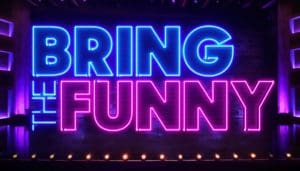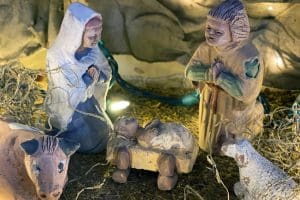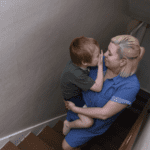As human beings, we often have a unique attachment to “things” in our lives. The things we appreciate or feel attached to might include items of clothing, pieces of jewelry, a piece of artwork, crafts made by a loved one, or other items with significant personal or sentimental value. For this week’s “Family History in Focus,” let’s reflect a bit on how such items can help us connect with past memories and how you can take a walk down memory lane with “memento memories.”
Who Gets Grandma’s Yellow Pie Plate?
When I first started working for the Cooperative Extension Service many years ago, it was not too long before I encountered an interesting and popular educational program that had been developed nearby in Minnesota. The lesson title? “Who Gets Grandma’s Yellow Pie Plate?”
Specifically, that educational lesson focuses on the topic of personal possessions and how they get passed down in families. For example, are there particular items that Grandma Ellen or Grandpa Bill used or shared with family members that got promised to a member of the family, such as a certain child or grandchild? Such items, often referred to as “non-titled property,” can nevertheless have great meaning and value for particular family members. Also, they can help us to explore meaningful memories in someone’s life or in the history of a family.
For a further introduction to this topic, the material from the University of Minnesota is accessible online and there is a workbook, a video, some quizzes and a podcast episode which all deal with the topic of passing on such heirloom items within families. In particular, the educational resources encourage learning how to value and pass on such items without getting into difficult family conflicts over “who gets what.” The link to the resources on “Who Gets Grandma’s Yellow Pie Plate” are available here: https://extension.umn.edu/later-life-decision-making/who-gets-grandmas-yellow-pie-plate#quizzes%2C-podcasts-and-family-stories-3220313
The Surprise Gift and the Baby Dress
In my family growing up, one of the things that my parents enjoyed doing was trying to give one another holiday gifts that had personal meaning and brought a tear to one’s eye. Of course, before too long, such gifts in our family became known as “cry gifts.” There are some legendary instances in my family, but I digress. I should note that this same pattern extends especially to my mother’s side of the family, and so I have observed this thoughtful gift-giving in a number of settings.
One year at Christmas, there was a bit of excitement circulating over a particular gift that had been prepared by my mother’s younger sisters. My mother Karen has two younger sisters, and the three of them occasionally like to regale the rest of us with the famous song “Sisters” (from Irving Berlin and the movie White Christmas), which is a treat when it happens. On this occasion, the “treat” was a thoughtful gift that was given to my mother, and as a youngster observing the opening of this gift I was not too sure what was happening. I recall watching my mother, who immediately became emotional upon opening the gift (which I couldn’t see that well from across the room), and also rather speechless (which is unusual for her). The gift was in a longish, nice box, it seemed, and finally it was turned about after much crying and emotional rejoicing by Mom—and there was a dress. A baby dress. Why such a hullabaloo over a baby dress?
Soon, the explanation came forward—this was not just any baby dress. This was a “baby blessing dress.” In fact, this was the beautiful baby dress that my dear mother, so many years earlier, had been blessed in when she received the ordinance of being given a name and a baby blessing after her birth. Suddenly, I started to understand. This was more than a baby dress. This was—MORE. This was memory. This was family history. This was joy—because my Mom was never supposed to live beyond a year old as a baby. And yet, she did, and brought six kids into the world against all odds, and that’s a whole other story, but hopefully you get the point.
This item, this memento, this baby blessing dress, was loaded with meaning and history and emotion and memory. It was precious to my mother, and so, it became precious and memorable to me.
Passing On Moments of Momento History
Have you ever held something that comes down from your family’s past? A photo? A piece of clothing? A ring? Something that makes a person or piece of history come alive?
While we should be thoughtful and not bestow large wardrobes on the next generation to deal with, at the same time we can thoughtfully select items to pass on that have some particular meaning. And, often, it may be something we don’t quite expect.
When my father passed away, we faced a bit of a dilemma. Well, he had 21 grandchildren, all of whom were a bit crazy about Grandpa Jack. They loved his rides together in the truck, his propensity to call every grandkid “Jimmy,” his moments of gentle fun, and his larger-than-life cowboy persona. How do you bestow a bit of “Grandpa Jack” on all 21 grandkids, not to mention his living children and a few other “adopted kids”?
In our case, my Dad happened to be a bit of a collector of things, and they were usually cool and interesting little things, and also happened to have more than his fair share of cowboy hats, cowboy boots, and various and sundry other items. I think we counted something like 12 or 13 pocket knives, 6 pairs of binoculars—you get the idea.
So, Uncle Sean (Yours Truly) became the “family auctioneer,” and we did an inventory of all the “Grandpa Stuff” that Grandma was happy to see get cleaned out and passed on to the next generation. We got it all organized and came up with some rules (everybody gets at least ONE thing that is first on their list; etc.), and divided out a bunch of pretend money (Monopoly game money) amongst all the grandkids and kids—and then, let the bidding begin. Our “family auction” ended up with some negotiation, and quite a bit of hilarity, and grandkids each carrying away a little box that held such “Grandpa treasures” as a pocket knife, a battered cowboy hat, an old fishing reel, a pair of binoculars, and more. Memories. Memento connections to a loved one, and which they can use to re-connect when they are missing a loved grandparent.
I have not come up with a formula to make such an exercise perfectly fair and perfectly fun, but this process worked for our family, and it made passing on items a positive experience rather than drudgery or difficulty. You might explore what kind of experience or process would work best for you in your family if you face such decisions.
Walking Down Memory Lane with Momento Memories
When a person enters the later years, he or she often becomes a bridge to past generations for those who are younger. Such things as historical events, natural disasters, family triumphs and tragedies, and personal memories may get passed down to grandchildren or other family members. A key role that grandparents occupy in family life can include being a family historian and acting as a mentor to younger generations.
Stories, pictures, documents, recordings, home movies or videos all hold great value in linking to the past. One category that I appreciate linked to this theme is “memento memories.” These are the memories we evoke and the stories we tell linked with particular material items, physical objects that have meaning and tell a story—like the baby dress. So, I encourage you to think about and plan some activities with loved ones in your family to share some “memento memories.”
A quick example. Years ago, cleaning out some drawers after my father passed away, I came across a folder with an old manila envelope in it. What were the contents? I opened it and found, to my surprise, two small, funny-shaped little hats made of cloth—what are called “beanies.” They had a logo on them that signified “Y” or “BYU”—Brigham Young University. Working out what the other items included in the packet were, and after consulting with my mother, I figured out that these were two “freshman beanie” hats that my father had been given and worn in his freshman orientation experience at Brigham Young University in the late 1950s. We talked and laughed about my dad’s freshman experience and my mom’s also, and I learned a little bit more about what it must have been like for him to enter college as a new, young student back then. This became a “memento memory” for me.
To get you thinking and assist you in giving a loved one a “guided tour” of your past memories and experiences, take some time to plan some sharing activities with family members or friends. Think about and collect at least three or four “memento items” of value that you can share with a child, grandchild, relative or other loved one. Such items might include a piece of jewelry, a sports uniform or other clothing item, or a piece of art from your life. Identify a time to meet and share one or two of the items with a loved one and share the story of the items and their meaning to you. If you want to make this a bit more involved, plan a family fireside where you might pull more of these items together and share the items and their stories with loved ones.
What will be the “baby blessing dress” in your family—the item that evokes particular memories? What might be the old battered cowboy hat, the yellow pie plate, or other item that has a story to be told?
Take time to slow down, pull together some of these mementoes, and make family history by sharing “memento memories” with your loved ones! And, I hope these memories become sweet and meaningful to you and those you love.




















